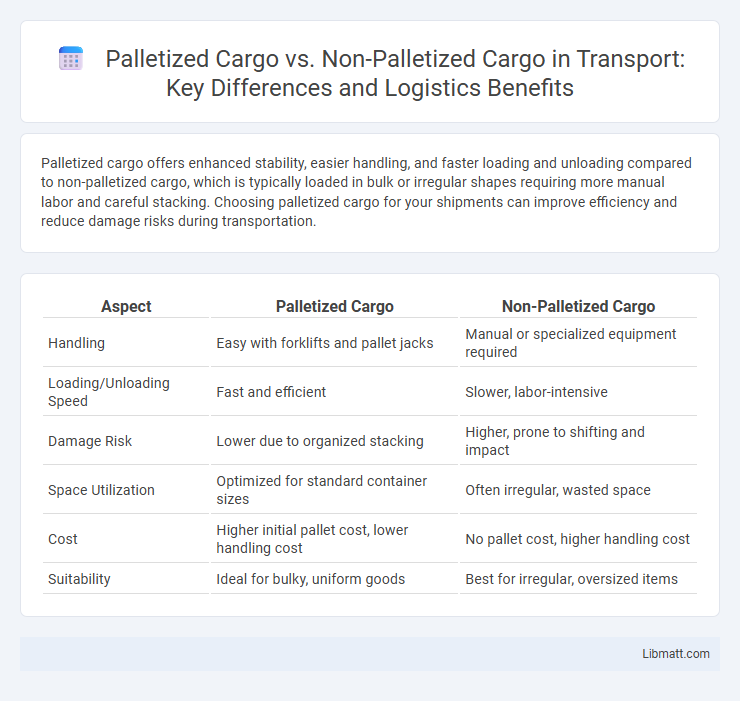Palletized cargo offers enhanced stability, easier handling, and faster loading and unloading compared to non-palletized cargo, which is typically loaded in bulk or irregular shapes requiring more manual labor and careful stacking. Choosing palletized cargo for your shipments can improve efficiency and reduce damage risks during transportation.
Table of Comparison
| Aspect | Palletized Cargo | Non-Palletized Cargo |
|---|---|---|
| Handling | Easy with forklifts and pallet jacks | Manual or specialized equipment required |
| Loading/Unloading Speed | Fast and efficient | Slower, labor-intensive |
| Damage Risk | Lower due to organized stacking | Higher, prone to shifting and impact |
| Space Utilization | Optimized for standard container sizes | Often irregular, wasted space |
| Cost | Higher initial pallet cost, lower handling cost | No pallet cost, higher handling cost |
| Suitability | Ideal for bulky, uniform goods | Best for irregular, oversized items |
Introduction to Cargo Handling Methods
Palletized cargo involves securing goods on standardized pallets, facilitating efficient handling, storage, and transport, reducing loading times and minimizing damage risks. Non-palletized cargo consists of items that are individually loaded or bundled without pallets, often requiring more manual labor and specialized equipment for safe handling. Understanding these methods is crucial for optimizing logistics operations, as palletization enhances automation compatibility and inventory control while non-palletized shipments offer flexibility for irregularly shaped or oversized items.
Defining Palletized Cargo
Palletized cargo refers to goods securely stacked and fastened onto standardized pallets, facilitating easier handling, storage, and transportation. This method enhances efficiency in loading and unloading processes, reduces the risk of damage, and optimizes space utilization in warehouses and vehicles. Understanding your cargo type is crucial for selecting the appropriate logistics solutions and ensuring smooth supply chain operations.
Understanding Non-Palletized Cargo
Non-palletized cargo refers to goods shipped without being secured on pallets, often requiring manual loading and specialized handling equipment. This type of cargo includes irregularly shaped items, bulk materials, and heavy machinery that cannot be easily stacked or standardized. Handling non-palletized cargo demands greater attention to securing loads to prevent damage and ensure safety during transportation.
Key Differences Between Palletized and Non-Palletized Cargo
Palletized cargo consists of goods securely stacked and wrapped on standardized pallets, enabling efficient handling, loading, and transportation using forklifts or pallet jacks, which significantly reduces loading times and minimizes product damage. Non-palletized cargo involves loose or irregularly shaped items that require manual handling, increasing labor costs and the risk of damage due to less uniform stacking and protection. The choice between palletized and non-palletized cargo impacts warehouse efficiency, shipping costs, and inventory management strategies within logistics and supply chain operations.
Advantages of Palletized Cargo
Palletized cargo offers increased efficiency in handling and storage by allowing for easier stacking and movement using forklifts, reducing loading and unloading times significantly. It enhances protection against damage during transit by securing goods in a stable, consolidated unit, minimizing the risk of shifting and impact. Furthermore, palletized cargo optimizes warehouse space utilization and improves inventory management through standardized sizes and better organization.
Benefits of Non-Palletized Cargo
Non-palletized cargo offers enhanced flexibility in handling irregularly shaped or oversized goods that cannot fit standard pallet dimensions, reducing the need for additional packaging and minimizing wasted space. It allows for more efficient use of container space when mixed cargo types are involved, potentially lowering transportation costs by maximizing volume utilization. This approach also simplifies direct access to individual items, facilitating quicker loading and unloading processes in specialized logistics operations.
Challenges in Handling Each Cargo Type
Palletized cargo offers easier stacking and transport stability but requires careful weight distribution to prevent damage during lifting and transit. Non-palletized cargo presents challenges in securing and protecting irregularly shaped items, increasing the risk of shifting and damage without proper packaging. Your choice impacts handling efficiency, as palletized cargo streamlines loading processes while non-palletized demands more manual intervention and customized securing methods.
Cost Implications and Efficiency
Palletized cargo significantly reduces handling time and labor costs by enabling faster loading and unloading processes compared to non-palletized cargo, which often requires more manual effort and careful placement. Your supply chain benefits from improved space utilization on transport vehicles, leading to lower freight charges and minimized damage risk, further reducing operational expenses. Choosing palletized cargo streamlines inventory management and enhances overall efficiency, ultimately delivering cost-effective logistics solutions.
Best Practices for Cargo Selection
Palletized cargo ensures efficient handling, protection, and standardized stacking, reducing damage risks and speeding up loading and unloading processes. Non-palletized cargo suits irregularly shaped or oversized items but demands careful packing and additional securing to prevent shifting during transit. Selecting the appropriate method depends on cargo dimensions, fragility, and transport mode to optimize safety and logistics efficiency.
Choosing the Right Method for Your Logistics Needs
Palletized cargo offers streamlined handling, improved protection, and faster loading and unloading, making it ideal for high-volume shipments and standardized storage systems. Non-palletized cargo provides greater flexibility for irregularly shaped goods or smaller quantities that don't fit pallet dimensions, often requiring customized packaging and careful manual handling. Your choice depends on balancing efficiency, cargo type, and transport requirements to optimize cost and safety in your logistics operations.
palletized cargo vs non-palletized cargo Infographic

 libmatt.com
libmatt.com